Page 63 of 399
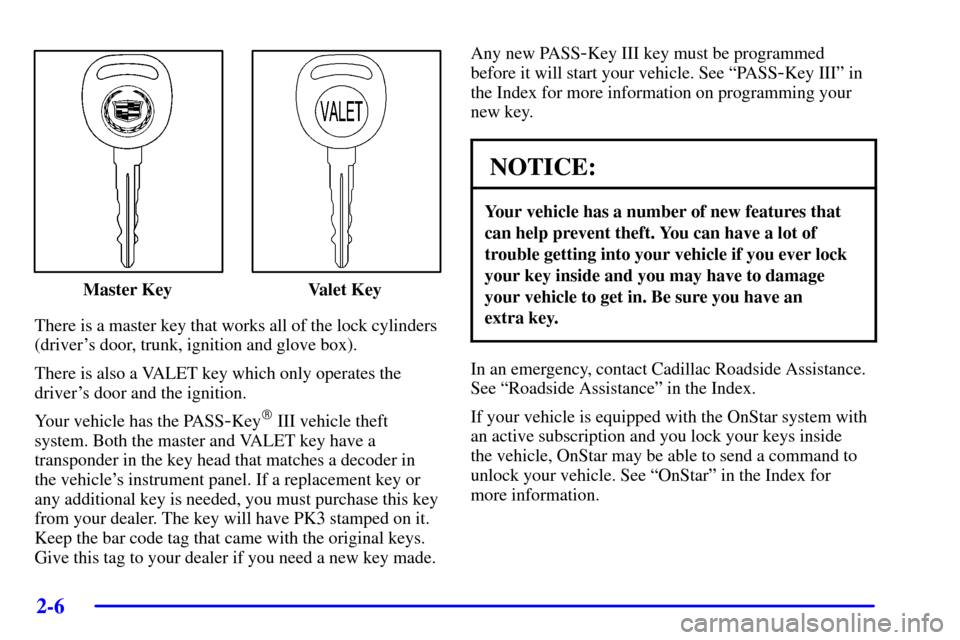
2-6
Master Key Valet Key
There is a master key that works all of the lock cylinders
(driver's door, trunk, ignition and glove box).
There is also a VALET key which only operates the
driver's door and the ignition.
Your vehicle has the PASS
-Key� III vehicle theft
system. Both the master and VALET key have a
transponder in the key head that matches a decoder in
the vehicle's instrument panel. If a replacement key or
any additional key is needed, you must purchase this key
from your dealer. The key will have PK3 stamped on it.
Keep the bar code tag that came with the original keys.
Give this tag to your dealer if you need a new key made.Any new PASS
-Key III key must be programmed
before it will start your vehicle. See ªPASS
-Key IIIº in
the Index for more information on programming your
new key.
NOTICE:
Your vehicle has a number of new features that
can help prevent theft. You can have a lot of
trouble getting into your vehicle if you ever lock
your key inside and you may have to damage
your vehicle to get in. Be sure you have an
extra key.
In an emergency, contact Cadillac Roadside Assistance.
See ªRoadside Assistanceº in the Index.
If your vehicle is equipped with the OnStar system with
an active subscription and you lock your keys inside
the vehicle, OnStar may be able to send a command to
unlock your vehicle. See ªOnStarº in the Index for
more information.
Page 71 of 399
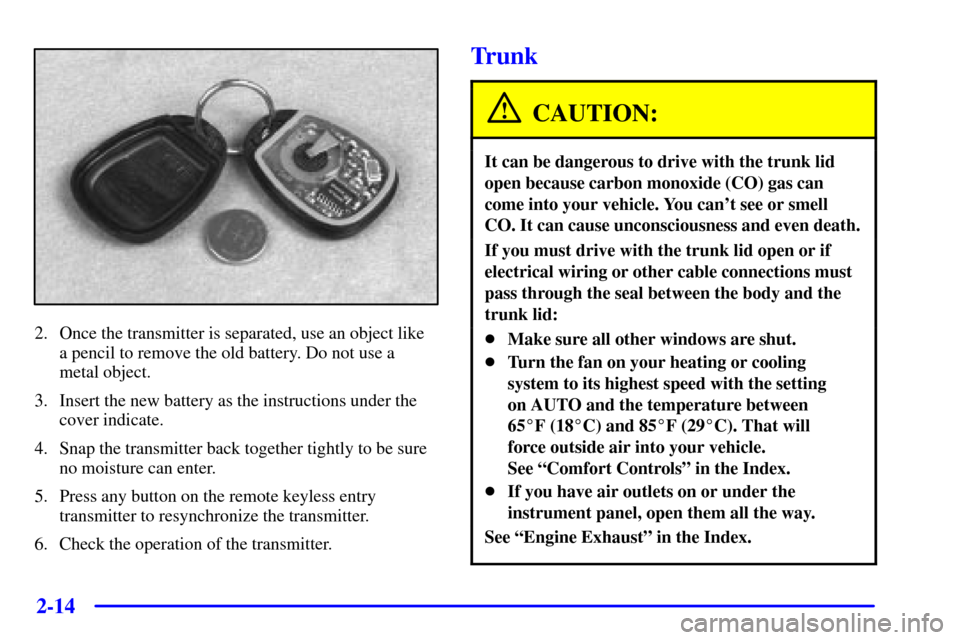
2-14
2. Once the transmitter is separated, use an object like
a pencil to remove the old battery. Do not use a
metal object.
3. Insert the new battery as the instructions under the
cover indicate.
4. Snap the transmitter back together tightly to be sure
no moisture can enter.
5. Press any button on the remote keyless entry
transmitter to resynchronize the transmitter.
6. Check the operation of the transmitter.
Trunk
CAUTION:
It can be dangerous to drive with the trunk lid
open because carbon monoxide (CO) gas can
come into your vehicle. You can't see or smell
CO. It can cause unconsciousness and even death.
If you must drive with the trunk lid open or if
electrical wiring or other cable connections must
pass through the seal between the body and the
trunk lid:
�Make sure all other windows are shut.
�Turn the fan on your heating or cooling
system to its highest speed with the setting
on AUTO and the temperature between
65�F (18�C) and 85�F (29�C). That will
force outside air into your vehicle.
See ªComfort Controlsº in the Index.
�If you have air outlets on or under the
instrument panel, open them all the way.
See ªEngine Exhaustº in the Index.
Page 72 of 399
2-15 Trunk Lock Release
The trunk lock release
button is located on the left
side of the instrument panel
below the lamp controls.
Press the trunk lock release button upward to open
the trunk. To use this feature, your vehicle must be in
PARK (P) or NEUTRAL (N) and the valet lockout
switch must be in OFF.
You can also press the button with the trunk symbol on
the remote keyless entry transmitter to open the trunk.
To disable this feature, see ªValet Lockout Switchº in
the Index.
Rear Seat Pass-Through Door (If Equipped)
The button for this feature is located in the trunk.
The rear
-seat armrest must be down for the pass-thru
door to open. To release the pass
-through door, press the
PUSH button located in the center of the trunk panel.
Page 75 of 399

2-18
Theft-Deterrent System
The SECURITY light is
located on the instrument
panel cluster.
If the ignition is off and any door is open, the SECURITY
light will flash, reminding you to arm the system.
To arm the system, do the following:
1. Open the door.
2. Lock the door using the power door lock switch with
the door open or the remote keyless entry transmitter.
The SECURITY light should come on and stay on.
3. Close all the doors. The SECURITY light should
go off within approximately 30 seconds.
If a door or a trunk is opened without a key or a remote
keyless entry transmitter, the horn will sound and the
lamps will flash for about 30 seconds.Remember, the theft
-deterrent system won't arm if you
lock the doors with a key or use the manual door lock.
It activates only if you use a power door lock with the
door open or the remote keyless entry transmitter.
To avoid activating the alarm by accident do
the following:
�The vehicle should be locked with the door key or
the manual door lock after the doors are closed if
you don't want to arm the theft
-deterrent system.
�Always unlock a door with a key or use the remote
keyless entry transmitter system. Pressing the unlock
button on the remote keyless entry transmitter
disables the theft
-deterrent system. Unlocking a
door any other way will activate the alarm when a
door or the trunk is opened.
If you activate the alarm by accident, unlock the driver's
door with your key. You can also turn off the alarm
by using the unlock button on the remote keyless
entry transmitter system, or by starting the car with
a valid key.
Changes or modifications made to this system by
other than an authorized service facility could void
authorization to use the theft system.
Page 79 of 399
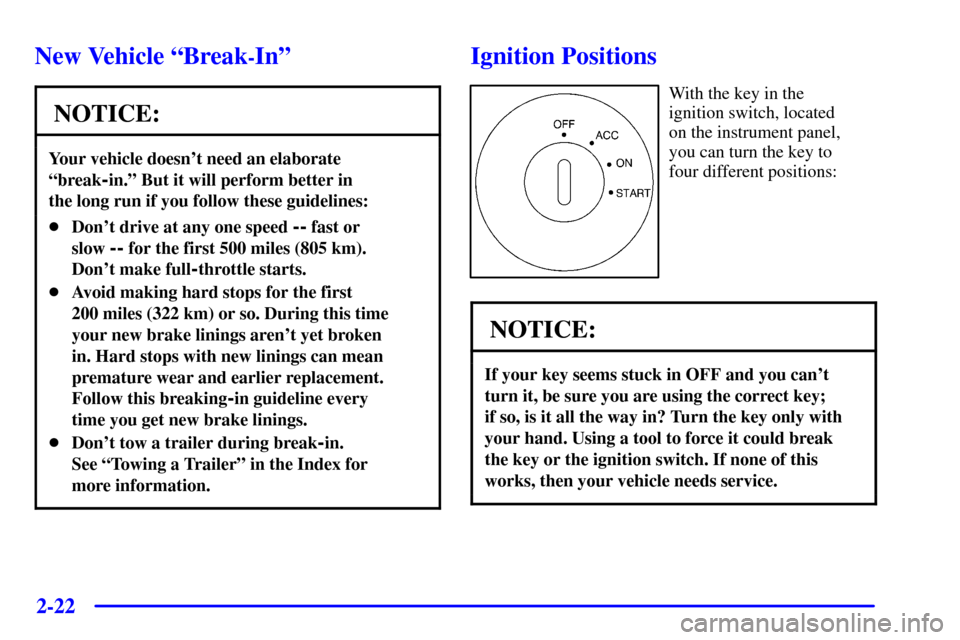
2-22
New Vehicle ªBreak-Inº
NOTICE:
Your vehicle doesn't need an elaborate
ªbreak
-in.º But it will perform better in
the long run if you follow these guidelines:
�Don't drive at any one speed -- fast or
slow
-- for the first 500 miles (805 km).
Don't make full
-throttle starts.
�Avoid making hard stops for the first
200 miles (322 km) or so. During this time
your new brake linings aren't yet broken
in. Hard stops with new linings can mean
premature wear and earlier replacement.
Follow this breaking
-in guideline every
time you get new brake linings.
�Don't tow a trailer during break
-in.
See ªTowing a Trailerº in the Index for
more information.
Ignition Positions
With the key in the
ignition switch, located
on the instrument panel,
you can turn the key to
four different positions:
NOTICE:
If your key seems stuck in OFF and you can't
turn it, be sure you are using the correct key;
if so, is it all the way in? Turn the key only with
your hand. Using a tool to force it could break
the key or the ignition switch. If none of this
works, then your vehicle needs service.
Page 87 of 399
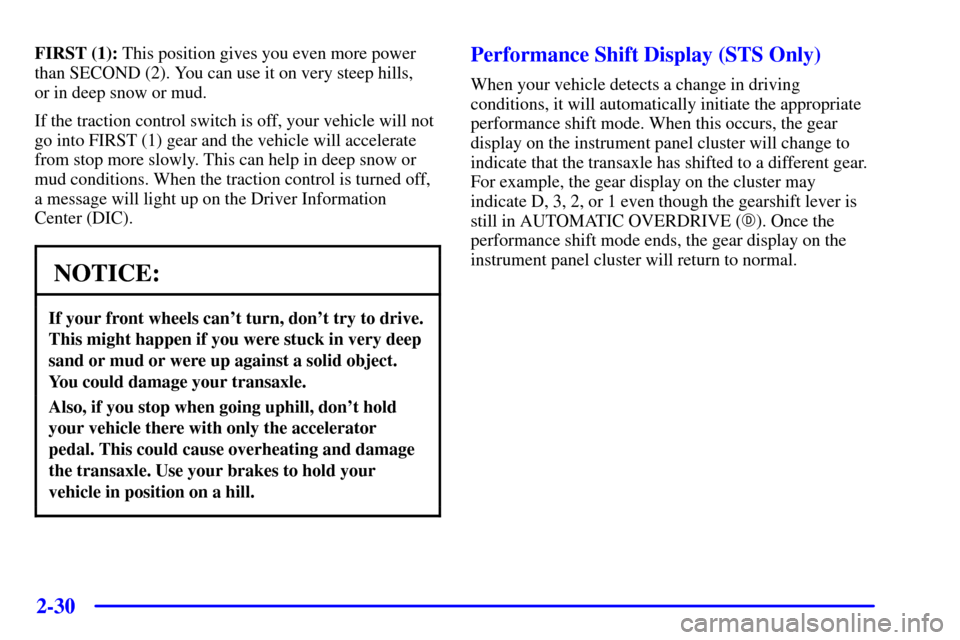
2-30
FIRST (1): This position gives you even more power
than SECOND (2). You can use it on very steep hills,
or in deep snow or mud.
If the traction control switch is off, your vehicle will not
go into FIRST (1) gear and the vehicle will accelerate
from stop more slowly. This can help in deep snow or
mud conditions. When the traction control is turned off,
a message will light up on the Driver Information
Center (DIC).
NOTICE:
If your front wheels can't turn, don't try to drive.
This might happen if you were stuck in very deep
sand or mud or were up against a solid object.
You could damage your transaxle.
Also, if you stop when going uphill, don't hold
your vehicle there with only the accelerator
pedal. This could cause overheating and damage
the transaxle. Use your brakes to hold your
vehicle in position on a hill.
Performance Shift Display (STS Only)
When your vehicle detects a change in driving
conditions, it will automatically initiate the appropriate
performance shift mode. When this occurs, the gear
display on the instrument panel cluster will change to
indicate that the transaxle has shifted to a different gear.
For example, the gear display on the cluster may
indicate D, 3, 2, or 1 even though the gearshift lever is
still in AUTOMATIC OVERDRIVE (�). Once the
performance shift mode ends, the gear display on the
instrument panel cluster will return to normal.
Page 88 of 399
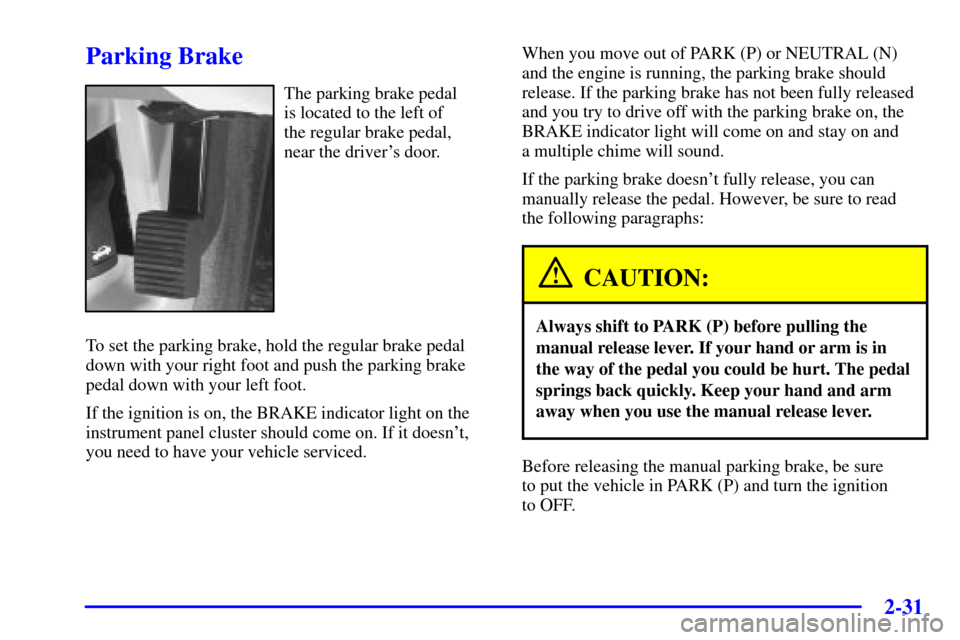
2-31
Parking Brake
The parking brake pedal
is located to the left of
the regular brake pedal,
near the driver's door.
To set the parking brake, hold the regular brake pedal
down with your right foot and push the parking brake
pedal down with your left foot.
If the ignition is on, the BRAKE indicator light on the
instrument panel cluster should come on. If it doesn't,
you need to have your vehicle serviced.When you move out of PARK (P) or NEUTRAL (N)
and the engine is running, the parking brake should
release. If the parking brake has not been fully released
and you try to drive off with the parking brake on, the
BRAKE indicator light will come on and stay on and
a multiple chime will sound.
If the parking brake doesn't fully release, you can
manually release the pedal. However, be sure to read
the following paragraphs:
CAUTION:
Always shift to PARK (P) before pulling the
manual release lever. If your hand or arm is in
the way of the pedal you could be hurt. The pedal
springs back quickly. Keep your hand and arm
away when you use the manual release lever.
Before releasing the manual parking brake, be sure
to put the vehicle in PARK (P) and turn the ignition
to OFF.
Page 89 of 399
2-32
Reach under the driver's side of the instrument panel
and pull down on the manual release lever, which is
located behind the parking brake pedal. Pull down on
the yellow tab as shown by the arrow in the illustration.
If the parking brake does not release, you should have
your vehicle towed to your dealer for service.
NOTICE:
Driving with the parking brake on can cause
your rear brakes to overheat. You may have to
replace them and you could also damage other
parts of your vehicle.
If you are towing a trailer and are parking on a hill,
see ªTowing a Trailerº in the Index.